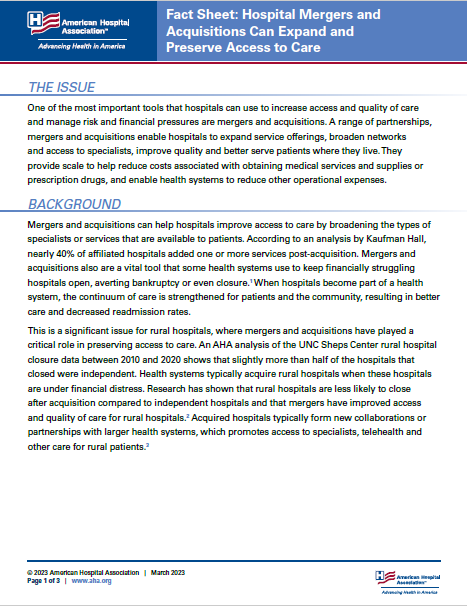Fact Sheet: Hospital Mergers and Acquisitions Can Expand and Preserve Access to Care
The Issue
One of the most important tools that hospitals can use to increase access and quality of care and manage risk and financial pressures are mergers and acquisitions. A range of partnerships, mergers and acquisitions enable hospitals to expand service offerings, broaden networks and access to specialists, improve quality and better serve patients where they live. They provide scale to help reduce costs associated with obtaining medical services and supplies or prescription drugs, and enable health systems to reduce other operational expenses.
Background
Mergers and acquisitions can help hospitals improve access to care by broadening the types of specialists or services that are available to patients. According to an analysis by Kaufman Hall, nearly 40% of affiliated hospitals added one or more services post-acquisition. Mergers and acquisitions also are a vital tool that some health systems use to keep financially struggling hospitals open, averting bankruptcy or even closure.1 When hospitals become part of a health system, the continuum of care is strengthened for patients and the community, resulting in better care and decreased readmission rates.
This is a significant issue for rural hospitals, where mergers and acquisitions have played a critical role in preserving access to care. An AHA analysis of the UNC Sheps Center rural hospital closure data between 2010 and 2020 shows that slightly more than half of the hospitals that closed were independent. Health systems typically acquire rural hospitals when these hospitals are under financial distress. Research has shown that rural hospitals are less likely to close after acquisition compared to independent hospitals and that mergers have improved access and quality of care for rural hospitals.2 Acquired hospitals typically form new collaborations or partnerships with larger health systems, which promotes access to specialists, telehealth and other care for rural patients.3
AHA Take
- Acquisitions and mergers help reduce health care costs and create a fiscally sustainable environment for health care delivery for patients and communities. AHA’s analyses show that hospital acquisitions are associated with a statistically significant 3.3% reduction in annual operating expenses per admission at acquired hospitals, along with a 3.7% decrease in net patient revenue per adjusted admission.4
- Acquisitions and mergers help drive quality. Research studies have shown that mergers and acquisitions are associated with a statistically significant reduction in inpatient readmission rates, and improvements in certain outcomes and performance measures, including a reduction in readmission and mortality measures.
- Partnerships, mergers or acquisitions help improve access to care for patients in rural and underserved communities. Research has shown that rural mergers are associated with quality improvement, including a reduction in the risk of mortality from certain conditions.5 Partnerships, mergers or acquisitions are a means for creating more cohesive care, making it easier for patients to access specialists or services in the acquiring system. In this way, consolidation ensures that care remains in the community.
- Federal policies and programs have a role in driving hospitals’ consolidation. Financial pressures can prompt mergers and acquisitions as providers struggle to access the resources they need to care for their communities. These financial pressures can result from the costs of complying with a complex web of local, state and federal regulations; excessive commercial payer administrative requirements; and efforts to reorient care delivery and payment to value-based models.
In addition, a major source of financial pressure for hospitals are the chronic underpayments by the Medicare and Medicaid programs. It is well-documented that neither program covers the cost of caring for its beneficiaries. Hospitals often struggle to make up for these financial losses. Merging with a hospital system can help some hospitals ease these financial burdens and improve patient care. - Local hospitals and health systems must contend with national, insurance companies. Though much is made of hospitals’ supposed market leverage, insurers have substantial market power in most of the markets in which they operate.6 Studies have shown that highly concentrated insurer markets are associated with higher premiums and that insurers are not likely to pass on to consumers any savings achieved through lower provider rates. Though many contend that insurers like UnitedHealth Group (over $324 billion in revenue in 2022, covering over 46 million Americans) and Elevance (over $155 billion in revenue over the same period, covering over 47 million Americans) are helpless in their dealings with local hospitals and health systems, the truth is far more complex.
- Hospital price growth has been low over the last decade, especially compared to other health care costs. According to the Bureau of Labor Statistics, hospitals’ price growth averaged about 2% annually over the past decade. In contrast, the annual premium for employer-based family coverage has increased 4.5% on average since 2010.8
Hospitals and health systems have faced historic challenges in the last several years. They will need continued flexibility to seek strategic opportunities and partners as they work to recover from the pandemic, overcome massive increases in the cost of caring, adjust to changing patient and community demographics, adopt new care delivery and payment models, and innovate for the future.
2 https://www.ncbi.nlm.nih.gov/pmc/articles/PMC9250050/
5 https://jamanetwork.com/journals/jamanetworkopen/fullarticle/2784342
6 https://www.ama-assn.org/system/files/competition-health-insurance-us-markets.pdf
7 https://www.healthaffairs.org/doi/10.1377/hlthaff.2015.0548
8 https://www.kff.org/health-costs/report/2021-employer-health-benefits-survey/8 https://www.kff.org/health-costs/report/2021-employer-health-benefits-survey/


